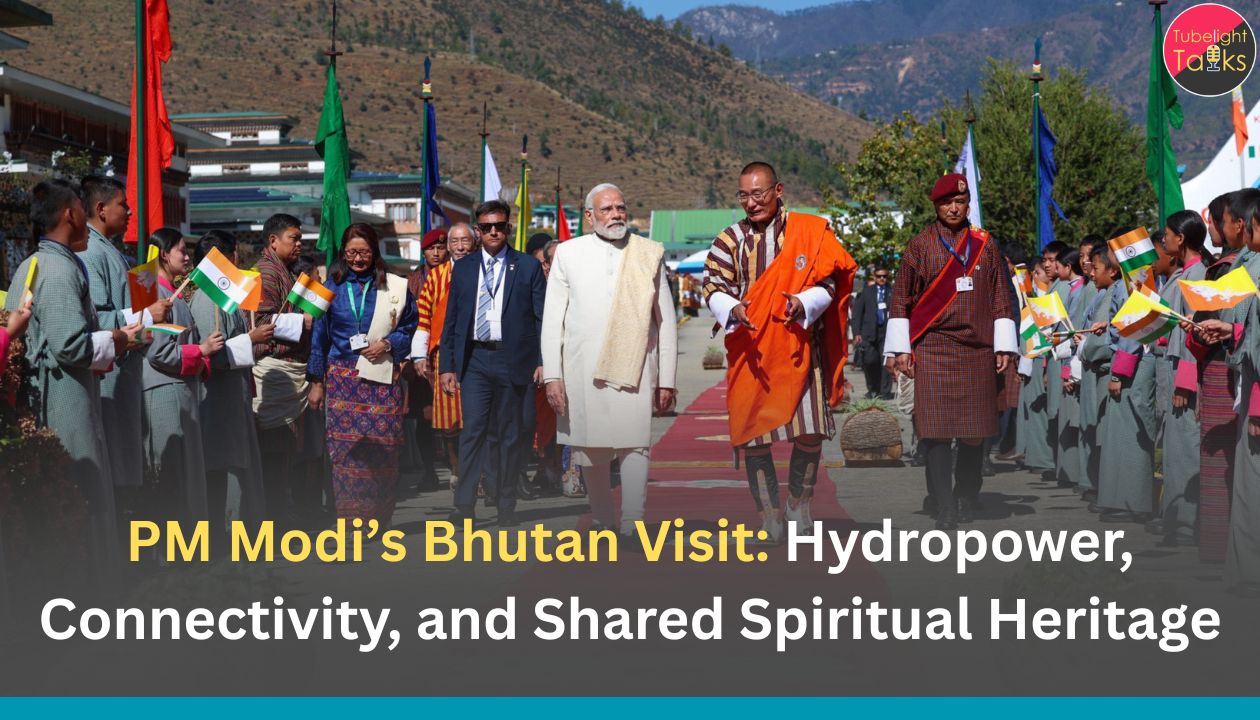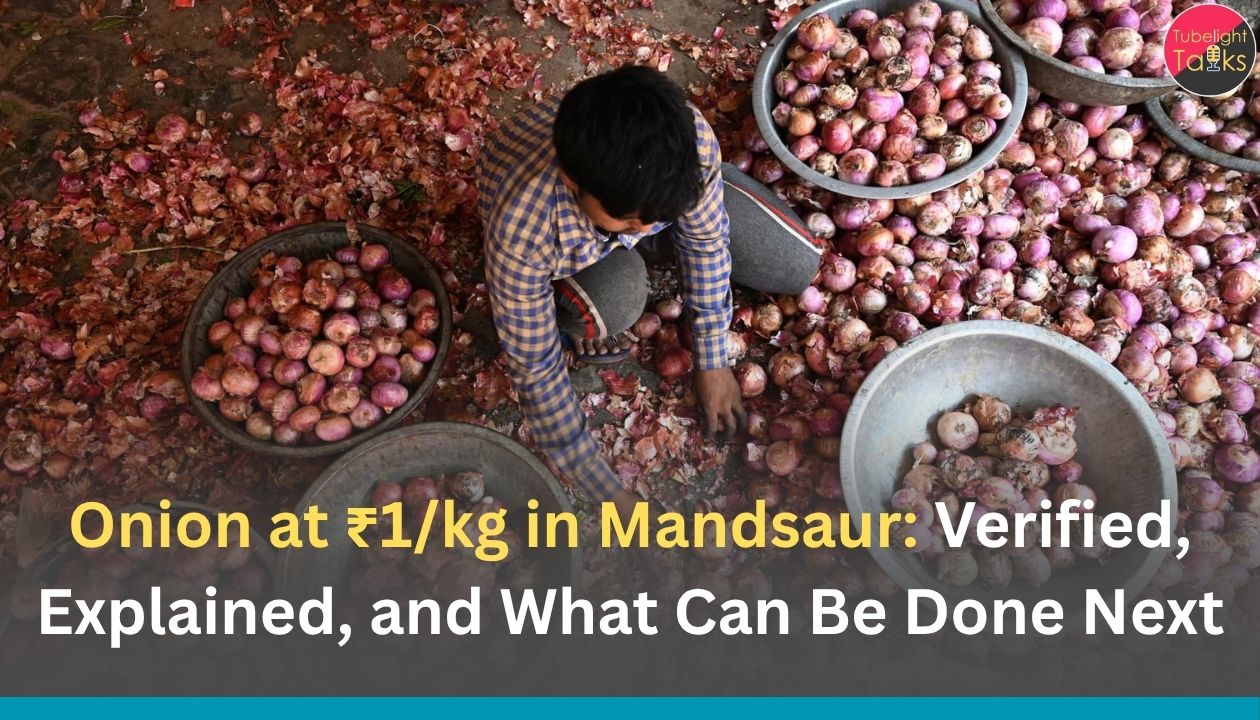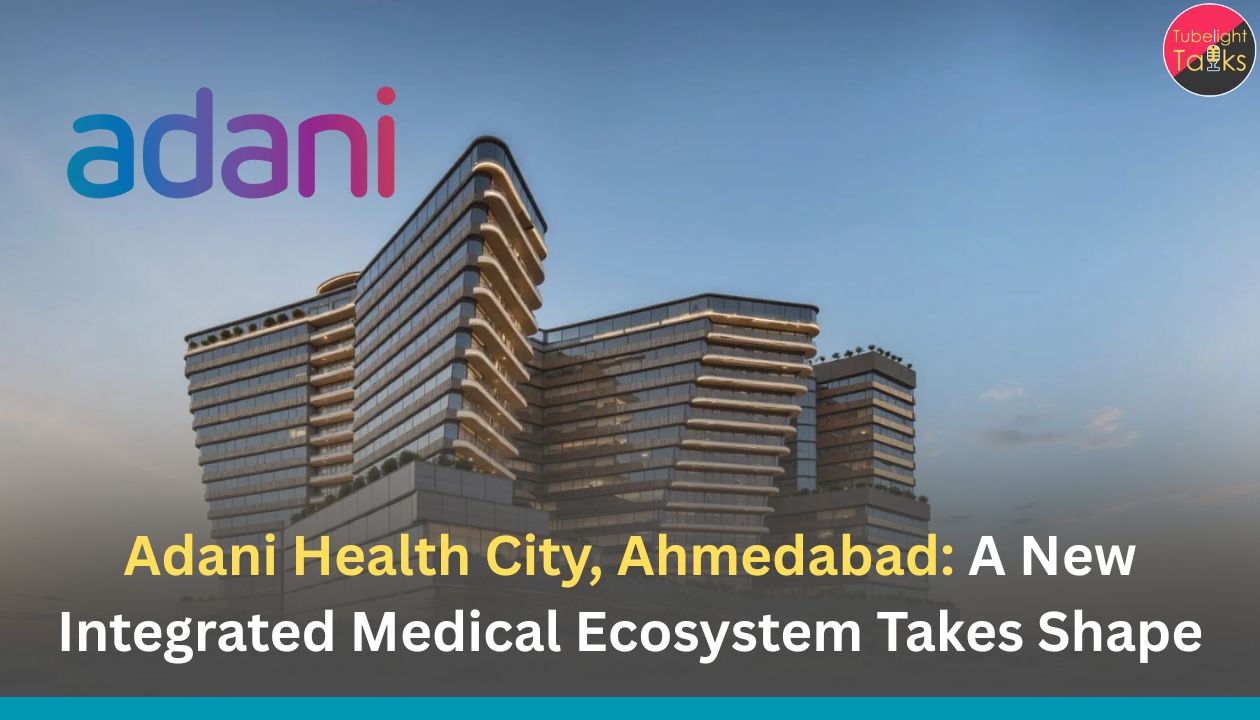PM Modi’s Bhutan Visit: Prime Minister Narendra Modi’s state visit to Bhutan (November 11–12, 2025) strengthened India–Bhutan relations across energy, connectivity, health, fintech, and culture. The headline deliverables include the inauguration of the 1,020 MW Punatsangchhu-II Hydroelectric Project, a ₹4,000 crore Line of Credit for Bhutan’s energy ambitions, understanding to resume Punatsangchhu-I, cross-border rail links, a new Immigration Check Post (ICP) at Hatisar for the Gelephu Mindfulness City, and UPI Phase-II for Bhutanese visitors in India.
The visit coincided with the 70th birth anniversary of the Fourth Druk Gyalpo and the public veneration of the Piprahwa Buddha relics, reflecting a deep spiritual connect between neighbors.
Key Outcomes at a Glance
- Energy: Joint inauguration of Punatsangchhu-II (1,020 MW); start of exports to India; India announced a concessional Line of Credit of ₹40 billion (₹4,000 cr) for energy projects; agreement to resume the main dam works for Punatsangchhu-I (1,200 MW).
- Connectivity: India to establish ICP at Hatisar (Assam) to facilitate Gelephu Mindfulness City; both sides welcomed recent Darranga ICP operationalization (Nov 2024) and Jogighopa IW Terminal & MMLP (Mar 2025).
- Rail Links: MoU (Sept 2025) for cross-border rail lines Gelephu–Kokrajhar and Samtse–Banarhat, with a steering committee set up for implementation.
- Digital/Space/STEM: UPI Phase-II to let Bhutanese visitors pay in India via local apps; ongoing space cooperation and capacity building across STEM, healthcare, and education.
- MoUs Signed: (1) Renewable Energy, (2) Health & Medicine, (3) PEMA–NIMHANS mental health linkage.
- Cultural/People-to-People: PM Modi joined celebrations for the Fourth Druk Gyalpo’s 70th and attended the Global Peace Prayer with the Piprahwa Buddha relics on public veneration.
Energy Partnership 2.0: Hydropower at the Core
Punatsangchhu-II goes live
A flagship of the bilateral hydropower story, Punatsangchhu-II (1,020 MW) was jointly inaugurated on November 11, 2025, with power exports to India commencing. The project is hailed as a “testament to friendship and exemplary cooperation.”
Independent reporting underscored the scale: collectively, Indian-backed hydropower in Bhutan contributes roughly 3,000 MW, and Punatsangchhu-II alone boosts Bhutan’s capacity by nearly 40%, strengthening its carbon-negative profile and export revenues.
Financing momentum: ₹4,000 crore Line of Credit
India announced a ₹40 billion (₹4,000 crore) concessional Line of Credit to support Bhutan’s energy projects—amplifying scope for grid upgrades, storage, and renewables that complement hydropower.
The long road to Punatsangchhu-I completion
A much-awaited development is the understanding to resume work on the main dam structure of Punatsangchhu-I (1,200 MW), clearing the path to complete what will become the largest jointly developed hydro project.
Beyond hydro: Renewables, storage, and hydrogen
A new MoU on Renewable Energy institutionalizes cooperation across solar, wind, biomass, energy storage, and green hydrogen, signaling a diversified clean-energy roadmap that complements river-based generation.
Connectivity & Trade Corridors: Rail, Road, River, and a New ICP
Hatisar ICP for Gelephu Mindfulness City
To unlock the potential of Gelephu Mindfulness City, India will set up an Immigration Check Post at Hatisar (Assam) to smooth entry for investors and visitors. This follows earlier upgrades—Darranga ICP’s operationalization in Nov 2024 and the Jogighopa Inland Waterways Terminal & Multimodal Logistics Park in Mar 2025—which together will ease movement of goods and people.
Cross-border rail links: Gelephu–Kokrajhar and Samtse–Banarhat
The two rail corridors will link Bhutan’s southern gateways directly to India’s network, widening market access for Bhutanese producers and lowering logistics costs for both sides. A Project Steering Committee has been constituted.
Digital, Space & Human Capital: Small Steps with Big Impact
The visit recorded progress in fintech via UPI Phase-II, which will allow Bhutanese visitors in India to scan QR codes using local apps for payments—a practical win for tourism, students, pilgrims, and SMEs. Both sides noted steady execution of the Joint Plan of Action on Space Cooperation and acknowledged the contributions of Indian teachers and nurses in Bhutan’s STEM and health systems.
A Cultural High: Buddha Relics, Global Peace Prayer & a Milestone Birthday
PM Modi addressed the celebration for the Fourth Druk Gyalpo’s 70th birth anniversary at Thimphu’s Changlimithang, emphasizing that “connectivity creates opportunity, and opportunity creates prosperity.”
He also participated in the Global Peace Prayer Festival, where Bhutan hosted the Piprahwa Buddha relics from India for public veneration—an evocative symbol of shared faith and heritage that the PM highlighted as a “symbol of peace and harmony.”
Timeline & Leader-Level Engagements
- Nov 11: Arrival in Bhutan; stadium event for the Fourth King’s 70th; audience with His Majesty The King; PCH-II inauguration.
- Nov 12: Audience with the Fourth Druk Gyalpo; participation in the Global Peace Prayer Festival; bilateral meetings with PM Tshering Tobgay.
Warm Exchange on X: PM Modi & PM Tobgay Highlight India–Bhutan Friendship
Bhutan Prime Minister Tshering Tobgay responded with a heartfelt note thanking PM Modi for visiting and extending warm wishes—underscoring the familial tone between the neighbours. See his post:
What It Means: Strategic Context & Economic Takeaways
The deliverables strengthen Bhutan’s role as a clean-energy hub, while providing India with dependable renewable imports and a friendly, stable neighborhood partner. The LoC, project restarts, and private sector interest (agreements involving Indian companies for future hydro projects) sharpen the investment pipeline. The timing—amid wider regional competition—reaffirms India’s intent to deepen energy connectivity and infrastructure with Bhutan.
For businesses, the Hatisar ICP and rail links promise easier access to the Northeast and beyond; for travelers and students, UPI Phase-II simplifies payments in India. The MoUs in health and mental health (PEMA–NIMHANS) create new avenues for clinical collaboration, training, and digital health pilots.
Fast Facts At A Glance
- Dates: Nov 11–12, 2025 (state visit).
- Hydro: PCH-II (1,020 MW) inaugurated; PCH-I (1,200 MW) main dam work to resume.
- Finance: ₹4,000 cr LoC for energy projects.
- Rail: Gelephu–Kokrajhar and Samtse–Banarhat links moving ahead.
- Border: Hatisar ICP announced for Gelephu Mindfulness City.
- Digital: UPI Phase-II to enable Bhutan-to-India retail payments via local apps.
- Culture: Global Peace Prayer, Piprahwa relics, Fourth Druk Gyalpo’s 70th celebrations.
Shared Values and the Path to Lasting Peace
Major power deals and border infrastructure matter—but lasting peace arises from right conduct, compassion, and inner stability. The visit’s most poignant images—the Buddha relics, the Global Peace Prayer, and public invocations of universal well-being—echo a timeless truth: material progress and spiritual wisdom must walk together.
Contemporary spiritual discourses by Sant Rampal Ji Maharaj emphasize scriptural alignment, devotion that improves daily life, and ahimsa in thought and deed—principles that resonate with the peace-first ethos on display in Thimphu this week. For seekers, his official platforms curate teachings, Satsang videos, and practical guidance on living with integrity and service.
Call to Action
Stay Informed, Stay Responsible
Use official sources for updates on India–Bhutan cooperation and plan your travel or business moves accordingly. Track PIB/MEA releases for project updates and UPI Phase-II rollout milestones; rely on Bhutan’s and India’s official handles for advisories.
Engage With the Moment—Outwardly and Inwardly
While we celebrate new hydropower, rail, and digital links, balance outer progress with inner growth—set aside time for study, service, and reflection. For those exploring a spiritual path rooted in scripture, consult Sant Rampal Ji Maharaj’s official resources for free teachings and Satsang streams.
Also Read: PM Narendra Modi’s Official Bhutan Visit Scheduled for November 11–12
FAQs: PM Modi’s Bhutan Visit and Outcome
1) What were the biggest outcomes of PM Modi’s Bhutan visit?
Inauguration of Punatsangchhu-II (1,020 MW); ₹4,000 cr concessional LoC for energy; understanding to resume PCH-I main dam; Hatisar ICP announcement; progress on cross-border rail links; MoUs in renewables, health, and mental health; and steps toward UPI Phase-II.
2) When did the visit take place and what events did PM Modi attend?
November 11–12, 2025. He addressed the Fourth Druk Gyalpo’s 70th birthday celebration at Changlimithang and joined the Global Peace Prayer, where Piprahwa relics were on public display.
3) What is the significance of Punatsangchhu-II and the LoC?
PCH-II adds large, clean capacity and export earnings for Bhutan while supporting India’s renewable mix. The ₹4,000 cr LoC helps finance energy infrastructure and future projects.
4) How will travelers and businesses benefit?
The Hatisar ICP will facilitate travel to Gelephu Mindfulness City; planned rail links will ease logistics; and UPI Phase-II will let Bhutanese visitors pay in India using local apps—great for tourists, students, and SMEs.
5) Which MoUs were signed?
(1) Renewable Energy (MNRE–MoENR), (2) Health & Medicine (ministries of health), and (3) PEMA–NIMHANS for mental-health capacity building and course development.










